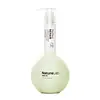What's inside
What's inside
 Key Ingredients
Key Ingredients

No key ingredients
 Benefits
Benefits

 Concerns
Concerns

 Ingredients Side-by-side
Ingredients Side-by-side

Water
Skin ConditioningCetearyl Alcohol
EmollientDimethicone
EmollientSteartrimonium Chloride
PreservativeRicinus Communis Seed Oil
MaskingPEG-90m
Emulsion StabilisingGlucose
HumectantPhyllostachys Pubescens Meristem Cell Lysate
Skin ConditioningArgania Spinosa Callus Culture Extract
Skin ConditioningMalus Domestica Fruit Cell Culture Extract
Skin ConditioningVitis Vinifera Fruit Cell Extract
Skin ConditioningGlutamic Acid
HumectantSodium PCA
HumectantKeratin
Skin ConditioningHydrolyzed Keratin
HumectantPrunus Domestica Seed Extract
EmollientArgania Spinosa Kernel Oil
EmollientLupinus Albus Seed Oil
Skin ConditioningMangifera Indica Seed Oil
EmollientTheobroma Grandiflorum Seed Butter
Skin ConditioningAdansonia Digitata Seed Oil
EmollientCarapa Guaianensis Seed Oil
Skin ConditioningSclerocarya Birrea Seed Oil
HumectantOpuntia Ficus-Indica Seed Oil
EmollientIsomalt
HumectantEthylhexyl Palmitate
EmollientDipentaerythrityl Tri-Polyhydroxystearate
EmollientBis-Behenyl/Isostearyl/Phytosteryl Dimer Dilinoleyl Dimer Dilinoleate
EmollientDipentaerythrityl Hexahydroxystearate/Hexastearate/Hexarosinate
Skin ConditioningBis-(Polyglyceryl-3 Oxyphenylpropyl) Dimethicone
Skin ConditioningXanthan Gum
EmulsifyingLecithin
EmollientBenzotriazolyl Dodecyl P-Cresol
UV AbsorberIsopropyl Alcohol
SolventGlycerin
HumectantTocopherol
AntioxidantEtidronic Acid
Tetrasodium Etidronate
Emulsion StabilisingPhenoxyethanol
PreservativeSodium Benzoate
MaskingParfum
MaskingCI 19140
Cosmetic ColorantCI 42090
Cosmetic ColorantCI 17200
Cosmetic ColorantLimonene
PerfumingLinalool
PerfumingWater, Cetearyl Alcohol, Dimethicone, Steartrimonium Chloride, Ricinus Communis Seed Oil, PEG-90m, Glucose, Phyllostachys Pubescens Meristem Cell Lysate, Argania Spinosa Callus Culture Extract, Malus Domestica Fruit Cell Culture Extract, Vitis Vinifera Fruit Cell Extract, Glutamic Acid, Sodium PCA, Keratin, Hydrolyzed Keratin, Prunus Domestica Seed Extract, Argania Spinosa Kernel Oil, Lupinus Albus Seed Oil, Mangifera Indica Seed Oil, Theobroma Grandiflorum Seed Butter, Adansonia Digitata Seed Oil, Carapa Guaianensis Seed Oil, Sclerocarya Birrea Seed Oil, Opuntia Ficus-Indica Seed Oil, Isomalt, Ethylhexyl Palmitate, Dipentaerythrityl Tri-Polyhydroxystearate, Bis-Behenyl/Isostearyl/Phytosteryl Dimer Dilinoleyl Dimer Dilinoleate, Dipentaerythrityl Hexahydroxystearate/Hexastearate/Hexarosinate, Bis-(Polyglyceryl-3 Oxyphenylpropyl) Dimethicone, Xanthan Gum, Lecithin, Benzotriazolyl Dodecyl P-Cresol, Isopropyl Alcohol, Glycerin, Tocopherol, Etidronic Acid, Tetrasodium Etidronate, Phenoxyethanol, Sodium Benzoate, Parfum, CI 19140, CI 42090, CI 17200, Limonene, Linalool
Water
Skin ConditioningUlmus Davidiana Root Extract
Skin ConditioningRosmarinus Officinalis Leaf Extract
AntimicrobialAloe Barbadensis Leaf Juice
Skin ConditioningBehentrimonium Methosulfate
Cetearyl Alcohol
EmollientPersea Gratissima Oil
Skin ConditioningPrunus Armeniaca Kernel Oil
MaskingCaprylic/Capric Triglyceride
MaskingGlycerin
HumectantPropanediol
SolventDiheptyl Succinate
EmollientCapryloyl Glycerin/Sebacic Acid Copolymer
Skin ConditioningPhenoxyethanol
PreservativeCaprylyl Glycol
EmollientSorbic Acid
PreservativePolydiallyl Phthalate
Panthenol
Skin ConditioningCaesalpinia Spinosa Gum
Skin ConditioningWater, Ulmus Davidiana Root Extract, Rosmarinus Officinalis Leaf Extract, Aloe Barbadensis Leaf Juice, Behentrimonium Methosulfate, Cetearyl Alcohol, Persea Gratissima Oil, Prunus Armeniaca Kernel Oil, Caprylic/Capric Triglyceride, Glycerin, Propanediol, Diheptyl Succinate, Capryloyl Glycerin/Sebacic Acid Copolymer, Phenoxyethanol, Caprylyl Glycol, Sorbic Acid, Polydiallyl Phthalate, Panthenol, Caesalpinia Spinosa Gum
Ingredients Explained
These ingredients are found in both products.
Ingredients higher up in an ingredient list are typically present in a larger amount.
Cetearyl alcohol is a mixture of two fatty alcohols: cetyl alcohol and stearyl alcohol. It is mainly used as an emulsifier. Emulsifiers help prevent the separation of oils and products. Due to its composition, it can also be used to thicken a product or help create foam.
Cetearyl alcohol is an emollient. Emollients help soothe and hydrate the skin by trapping moisture.
Studies show Cetearyl alcohol is non-toxic and non-irritating. The FDA allows products labeled "alcohol-free" to have fatty alcohols.
This ingredient is usually derived from plant oils such as palm, vegetable, or coconut oils. There is debate on whether this ingredient will cause acne.
Due to the fatty acid base, this ingredient may not be Malassezia folliculitis safe.
Learn more about Cetearyl AlcoholGlycerin is already naturally found in your skin. It helps moisturize and protect your skin.
A study from 2016 found glycerin to be more effective as a humectant than AHAs and hyaluronic acid.
As a humectant, it helps the skin stay hydrated by pulling moisture to your skin. The low molecular weight of glycerin allows it to pull moisture into the deeper layers of your skin.
Hydrated skin improves your skin barrier; Your skin barrier helps protect against irritants and bacteria.
Glycerin has also been found to have antimicrobial and antiviral properties. Due to these properties, glycerin is often used in wound and burn treatments.
In cosmetics, glycerin is usually derived from plants such as soybean or palm. However, it can also be sourced from animals, such as tallow or animal fat.
This ingredient is organic, colorless, odorless, and non-toxic.
Glycerin is the name for this ingredient in American English. British English uses Glycerol/Glycerine.
Learn more about GlycerinPhenoxyethanol is a preservative that has germicide, antimicrobial, and aromatic properties. Studies show that phenoxyethanol can prevent microbial growth. By itself, it has a scent that is similar to that of a rose.
It's often used in formulations along with Caprylyl Glycol to preserve the shelf life of products.
Water. It's the most common cosmetic ingredient of all. You'll usually see it at the top of ingredient lists, meaning that it makes up the largest part of the product.
So why is it so popular? Water most often acts as a solvent - this means that it helps dissolve other ingredients into the formulation.
You'll also recognize water as that liquid we all need to stay alive. If you see this, drink a glass of water. Stay hydrated!
Learn more about Water